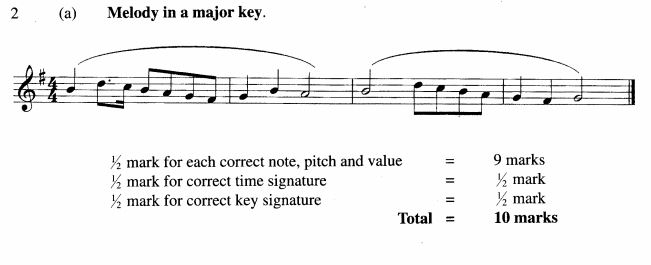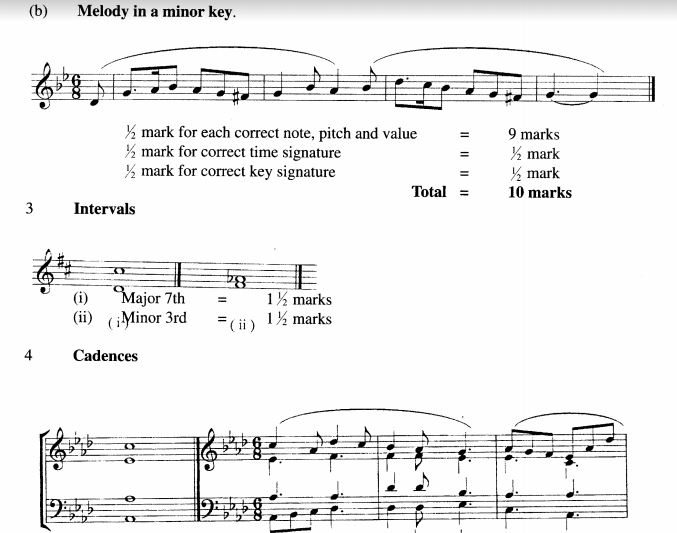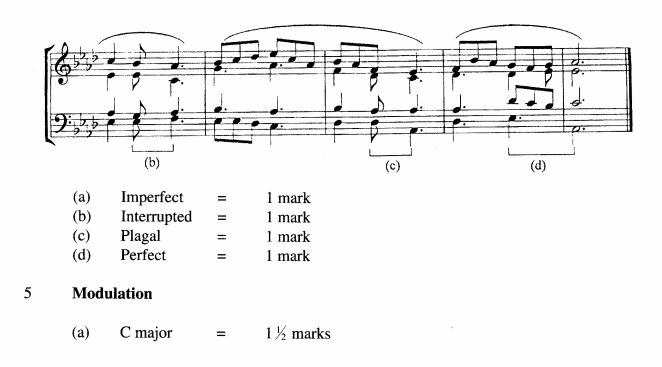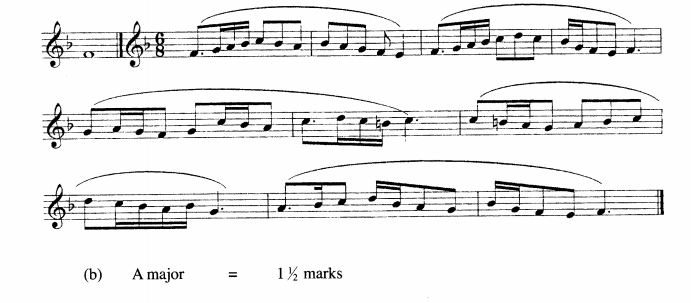KCSE Past Papers Music 2011
Click Here - Free KCSE Past Papers » KCSE Past Papers Music 2011 » Free Downloads » KCSE Papers & Marking Schemes
5.4.1 Music Paper 3 (511/3)
Answer questions from all sections.
SECTION A: BASIC SKILLS (32 marks)
1 Either (a) Continue the following opening to make a melody of I6 bars for voice incorporating appropriate dynamics and tempo directions. Modulate to the dominant before returning to the tonic key.
(12 marks)

Or (b) Using staff notation, compose a melody and set to it the text below. Add phrase marks to 2 indicate cadential points. (12 marks)
Kukongoka huna budi
Hata upake marashi
Ujana ni kama Moshi
Ukienda haurudi
2 Harmonize the following melody for Soprano, Alto, Tenor and Bass (SATB). Use the following chords: I, II, IV, V and Vl. (20 marks)

SECTION B: HISTORY AND ANALYSIS (48 marks)
3 AFRICAN MUSIC
(a) (i) Name two Kenyan ground bows. (2 marks)
(ii) State two methods of playing ground bows. (2 marks)
(ii) Name the Kenyan Communities that play the instruments named in (i) above. (2 marks)
(b) Name two costumes used in the performance of Sengenya Dance. (2 marks)
(c) State three advantages of call and response as a singing stylel (3 marks)
(d) State three functions of lullabies in an African traditional society. (3 marks)
4 WESTERN MUSIC
Answer any two of the questions (a). (12), (c) and (d).
(a) GIOVANI PALESTRINA
(i) What was Palestrina’s nationality? (1 mark)
(ii) Outline any two public appointments that enhanced Palestrina’s contribution to music performance in his home town. (2 marks)
(m) Describe three characteristics of Palestrina’s music. (3 marks)
(iv) Name Palestrina‘s most famous mass. (1 mark)
(b) WOLFGANG A. MOZART
(i) Name the period of music history in which Mozart lived. (1 mark)
(ii) Outline any two factors that motivated Mozart to compose in virtually every popular form of the day. (2 marks)
(iii) State two factors that influenced Mozart to compose music for the church. (2 marks)
(iv) When Mozart moved to Vienna in 1781, he was successful at first but his popularity declined later on.
Outline any two reasons that may have caused the decline. (2 marks)
(c) PETER I. TCHAIKOVSKY
(i) Name any choral work by Tchaikovsky. (1 mark)
(ii) What type of work is Eugene Onegin‘? (1 mark)
(iii) Explain how three of the following contributed to Tchaikovsky/‘s musical career:
New Moscow Conservatory
Cambridge University
National group of young Russian Composers
Petersburg Conservatory (3 marks)
(iv) Outline any two stylistic features of Tchaikovsky‘s music. (2 marks)
(d) BENJAMIN BRITTEN
(i) In which period of music history did Britten live? (1 mark)
(ii) State any two events that influenced Britten’s music education background. (2 marks)
(m) What type of work is the War Requiem? (1 mark)
(iv) For what purpose was the War Requiem composed? (1 mark)
(v) Name any work for children written by Britten. (l mark)
(vi) Apart from the full scale operas, name any other type of opera by Britten. (1 mark)
5 PRESCRIBED TRADITIONAL AFRICAN MUSIC SET WORK
Turkana Folk Song by Kakuma Primary School
KIE Recording of KMF 2008.
(a) Describe the opening section of the performance. (2 marks)
(h) State the composition of the singers. (1 mark)
(c) Name any two instruments played in the performance. (2 marks)
(d) Identify any two types of vocal ornamentation heard in the performance. (2 marks)
(e) This performance is in three distinct sections. Describe each section in terms of tempo variation. (3 marks)
6 PRESCRIBED WESTERN MUSIC SET WORK
F. Schubert: Piano Quintet e The Trout(1 marks)
(a) Name the instrument that plays the theme for the first 2'0 bars (bar 1 to bar 20)(1 marks)
(b) Which instrument picks up the theme and plays it throughout Variation 1?(1 marks)
(c) Into which key does Variation 1 modulate?(1 marks)
(e) With reference to bar numbers, identify each of the following(1 marks):
(i) Descending scalic movement(1 marks)
(ii) Use of arpeggios(2 marks)
(iii) Use of Chromaticism.(1 marks)
(2) Name the cadence at the end of bar 100.
(f) Name any two omaments used in this work.
(g) Describe the relationship between the piano parts in Variation 1 and 3.
SECTION C: GENERAL MUSIC KNOWLEDGE (20 marks)
7 (a) (i) Outline five roles of music in an African traditional marriage ceremony.(5 marks)
(ii) State any four functions of music in the electronic media services.(4 marks)
(b) Define the following:
(i) Binary form(1 marks)
(ii) Overture(1 marks)
(iii) Idiophone(1 marks)
(iv) Timbre(1 marks)
(V) Instrumental ensemble(1 marks)
(c) Describe each of the following drums as either double headed or single headed:
(i) Isukuti
(ii) Mukanda
(iii) Kalapapla
(iv) Chapuo
(d) (i) State two functions of Music Copyright Society of Kenya (MCSK).(2 marks)
(ii) State the origin of the Kenya National Anthem tune.(2 marks)
(iii) Explain the style of performance of the Kenya National Anthem.(1 marks)
32.0 MUSIC (511)
32.1 Music Paper 2 (511/2)
Rhythm on monotone in simple time
(a) Drum rhythm.





312 Music Paper 3 (511/3)
SECTION A: BASIC MUSIC SKILLS (32 marks)
1 (a) 16 bar melody.1 mark
Modulation and back.2 marks
Cadences (1 mark each for two).2 marks
Lyricism 2 marks
Rhythm variety.1 mark
Melodic cuwe, including climax.1 mark
Melodic shape (plan, form).1 mark
Dynamics.1 mark
Tempo variation.1 mark
Total 12 marks
Or
(b) Lyrical melody.2 marks
Syllabic division (-5- mark for each line).2 marks
Text setting and accentuation (L mark for each line).2 marks
Cadences (1 mark each for any 5).2 marks
Melodic shape. (plan, form).2 marks
Phrase marks (marked as a whole).1 mark
Rhythm variety.1 mark
Total 12 marks
2. 1/2 mark for each correct chord/accept passing notes correctly harmonised)
Voice leading (Tenor, Alto, Bass). (1 mark each) 3 marks
Cadence (2 marks for each cadence at phrase ends).
Appropriate range (mark as a whole).1 1/2
Appropriate progression.4 marks
Total 20 marks
Deduct marks (maximum 4 marks) for the following faults in harmonic progression: ‘Parallel octaves.1 mark each
~Consecutive 5"“.1 mark each
-Doubled st“.1 mark each
'Crossing of parts.1 mark each
-Spacing.
‘Stems (mark as a whole).1 mark each
~Rhythm (Wrong rhythms - mark as a Whole.1 mark each
'Unisons to Sm and vice versa.1 mark each
‘Wrong use of inversions.1 mark each
3. (a) (i) - Mbaito
- Endevendeve/Indigidi
- Nderemo
l mark each for any 2 correct instruments.
Played by: - stricking the string With a stick.
- plucking the string.
- strumming.
l mark each for any 2 correct method.
- Mbaito played by the Kisii.
- Endevendeve/Indigidi played by the Luhya.
- Nderemo played by the Kikuyu.
1 mark each for any 2 correct communities. (b) - Kio
- Kikoi
- Chiriaka
- Hando
- Kituku
1 mark each for any 2 correct relevant costumes.
(c) - facilitates distribution of roles.
- makes mastery of the text easier.
- involves the whole group.
- keeps every participant alert in case of key change and entries.
- pitching easily set by the soloist.
- creates a variety of texture.
- makes performance interesting.
1 mark each for any 3 advantages.
(d) - to soothe the baby to stop crying.
- to lull the baby to sleep.
- to express the mother’s love to the baby.
- to assure the baby of emotional security.
- entertain the baby.
1 mark each for any 3 relevant functions.
4. (a)
(i) Italian.
(ii) - was a choir boy in his church in Rome.
- was an organist and choirmaster in the Cathedral in his home town.
- was made a member of the papal choir.
- choinnaster of the Sistine Chapel.
1 mark each for any 2 relevant appointment.
(m) - A capella
- vocal music based on old modes.
- Words always in Latin.
- smooth and stepwise movement.
- music effective for expression of religious feelings.
1 mark each for any 3 relevant characteristics.
(iv) Missa Papae Marcelli. (1 mark)
(b) Classical/Viennese Period. (1 mark)
/I — Gained useful acquittance in the various types of music through his extensive ~ travels.
- Interaction with his contemporaries who were great musicians.
- cosmopolitan culture of Salzburg and Vienna where he stayed/settled
- familiarity with the music of the great composer of his period.
1 mark each for any 2 relevant factors. (2 marks)
(iii) His father worked as a musician for the Archbiship of Salzburg.
- Mozart himself worked as a musician for the Archbishop of Salzburg.
- His attachment to Padre Martini a grand old man and monk in Italy who gave him instructions in counter point. ‘
1 mark each for any 2 relevant points. (2 marks)
(iv) - Failed to find a permanent position.
- His music became more complicated.
- Music was highly spiced with dissonance.
- His styles were unpopular.
- His publisher was no longer interested in publishing the work.
1 mark each for any 2 relevant points. (2 marks)
(c) (i) - Liturgy of St. John Chrysostom . (OP 41)
- Russian Vesper Service. (OP 52)
l mark for any 1 relevant name. (1 mark)
(ii) Opera
(iii) - New Moscow Conservatory - had his appointment as a professor of music.
- Cambridge University - conferred a Doctorate in Music.
- National group of young Russian Composers.
Influenced his choice of music - more national style.
- Mrs. Von Meek - Supported him financially to enable him to continue composing.
- Commissioned his compositions.
- Petersburg Conservatory - He received his music education.
1 mark each for any three contributions. (3 marks)
(iv) - His music contains elements of French, Italian and German Music.
- Fused national and international elements.
- Beautiful melodies that stretched and leap widely.
- Repeats melodies over and over.
- Louder dynamics.
- Fuller orchestration.
- Striking contrasts and alternations of strings, wood winds and brasses.
- Sharp contrast of tempo, dynamics and thematic materials.
- Powerful climaxes.
1 mark each for any 2 features. (2 marks)
(d) (i) Twentieth Century. (1 mark)
(ii) - Studied piano and composition at a public school in London.
- Studied composition at Royal College of Music London.
- Had private music lessons with Frank Bridge.
- Had music lesson with R. Von Williams.
1 mark each for any 2 relevant points. (2 marks)
(iii) - Choral work. (1 mark)
(iv) - Opening of the new Coventary Cathedral (1 mark)
(v) - Young persons guide to orchestra.
- The instruments of the orchestra.
- Lets make an Opera.
- Noye’s Fludde.
1 mark each for any 1 correct work. (1 marks)
(vi) - chamber operas
- church operas
1 mark each for l relevant type of opera. (1 mark)
SECTION B:
PRESCRIBED TRADITIONAL AFRICAN MUSIC SET WORK.
5. Turkana Folk song by Kakuma Primary School.
K.I.E. Recording by KMF 2008.
(a) Starts with two male voices interjection, followed by the hom, then the girls ululation followed by the whole group singing.
2 marks for the correct description. (2 marks)
(b) The performance is composed of mixed voices.
The performance is composed of boys and girls.
The performance is compared of male and female voices.
1 mark for any correct statement of the composition of the singers.
(c) Adet/Atom (Horn)
Echorot (jingles)
(whistle)
(1 mark)
1 mark each for any 2 correct instruments. (2 marks)
(d) Ululation.
Interjection.
Shouts .
1 mark each for any 2 types of ornamentation. (2 marks)
(e) Section 1 in fairly fast tempo.
Section 2 starts with a slower interlude then returns to fast tempo.
Section 3 in a slightly slower tempo.
1 mark each for each relevant description. (3 marks)
Total 30 marks
6 (a) Violin
(b) Piano
(c) A major
(d) (i) Descending scalic movement - Bar 49, 51, 59
(ii) Use of arpeggios - Bar 43, 47
(iii) Cromaticism. - Bars 68-69
Perfect cadence in D minor.
(f)- Appoggiatura;
- Trill; ‘
- Acciacatura.
1 mark each for any 2 correct ornaments. (2 marks)
(g)- played in unison.
- played in unison, an octave apart.
- both parts played on the higher register of the piano (using the treble clef).
1 mark for any 1 correct answer. (1 mark)
SECTION C: GENERAL MUSIC KNOWLEDGE (20 marks)
7. (a) (i) to welcome the bride into her new home.
to praise and congratulate the bride and groom.
to educate the couple on family life.
to bid farewell to the bride.
to entertain the couple and guests at the wedding.
to offer prayers for the bride and groom for a bright and fruitful future.
to praise the families of the couple.
to test the patience of the couple.
to urge the society to support the couple.
1 mark each for any 5 relevant roles. (5 marks)
(ii) Back up in films.
Interludes in radio and television programmes.
Commercial advertisements over the radio and television.
Back up in plays.
Entertainment.
Communication of public policies to the masses.
Dissemination of information.
1 mark each for any 4 relevant functions.
(4 marks)
(b) (i) A form of two sections of which the first ends in a new key and the second
beginning in that new key, leads back to the original key.
(ii) Orchestral introduction to an oratorio or an opera.
(iii) A self sounding percussion instrument.
(iv) Quality of sound or tone colour of sound.
(v) A group of players playing different instruments together.
(c) (i) Isukuti — single headed.
(ii) Mukanda - double headed.
(iii) Kalapala - single headed.
(iv) Chapuo 1- double headed.
(d) (i) To register musicians.
To pay musicians royalties.
To protect musicians copyrights.
To educate musicians about their rights.
Educatethe public on the issues relating to music copyright.
1 mark each for any 2 relevant roles.
(ii) Pokomo.
(iii) Solo-chorus style.
Total 20 marks
Kenya Scholarships for Undergraduate Students » Kenya Scholarships for Postgraduate Students » Undergraduate Scholarships for Kenyan Students » Kenya Undergraduate Scholarships » Full Undergraduate Scholarships for Kenyans » Kenya Postgraduate Scholarships » Scholarships & Grants » Undergraduate Scholarships » Universities in Kenya » Kenya Universities and Colleges Central Placement Service (KUCCPS) » Colleges in Kenya » KASNEB Registration & Results » Secondary Schools Scholarships in Kenya » Undergraduate & Graduate Scholarships for Kenyans
Scholarships for African Students » Undergraduate Scholarships » African Women Scholarships & Grants » Developing Countries Scholarships » Erasmus Mundus Scholarships for Developing Countries » Fellowship Programs » Funding Grants for NGOs » Government Scholarships » LLM Scholarships » MBA Scholarships » PhD and Masters by Research Scholarships » Public Health Scholarships - MPH Scholarships » Refugees Scholarships » Research Grants » Scholarships and Grants
Scholarships in Australia » Scholarships in Belgium » Scholarships in Canada » Scholarships in Germany » Scholarships in Italy » Scholarships in Japan » Scholarships in Korea » Scholarships in Netherlands » Scholarships in UK » Scholarships in USA
Scholarship 2025/26
Current Scholarships 2025/2026 - Fully FundedFull Undergraduate Scholarships 2025 - 2026
Fully Funded Masters Scholarships 2025 - 26
PhD Scholarships for International Students - Fully Funded!
Funding Opportunities for Journalists 2025/2026
Funding for Entrepreneurs 2025/2026
***
